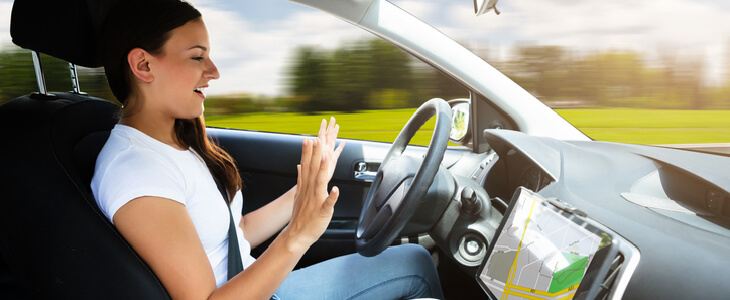Self-driving car accidents in California can result in serious and fatal injuries. Because these vehicles are not completely autonomous at this time, drivers are ultimately responsible for controlling their vehicles. While technical glitches can play a role in a collision, driver error is the cause of most self-driving car accidents. In both cases, it takes an experienced self-driving car accident attorney to hold the responsible party accountable.
If you or a loved one has been seriously injured in a collision involving an autonomous vehicle, turn to J&Y Law. Our legal team will work tirelessly to help you obtain just compensation. Given the challenges of determining the cause of a self-driving car accident, it is essential to have our capable attorneys handle your claim. Contact us now for a free consultation.
What Is A Self-Driving Car?
An autonomous or self-driving car is one that is technologically capable of sensing its own environment and operating without human involvement. SAE International (formerly named the Society of Autonomous Engineers) defines 6 levels of autonomous driving, ranging from Level 0 (fully manual) to Level 5 (fully autonomous):
Level 0 – No Automation
The driver performs the “dynamic driving task” and operates all functions of the vehicle at all times. However, there may be technological systems in place to help the driver, such as automatic emergency braking or lane-keeping assist.
Level 1 – Driver Assistance
This is the lowest level of automation. Level one autonomous vehicles use a single automated system, such as steering assistance or adaptive cruise control, but not both. The driver monitors all other aspects of driving, such as steering or braking, and must be prepared to disengage automated driving systems if necessary.
Level 2 – Partial Driving Automation
Level two automation vehicles are the highest level currently available to consumers in California and around the country. These self-driving cars are equipped with advanced driver assistance systems (ADAS). The vehicle can control steering, accelerating, and decelerating, but the driver must remain in the driver’s seat and be able to take control at any time. Both Tesla Autopilot and Cadillac (General Motors) Super Cruise are Level 2 automated systems.
Level 3 – Conditional Driving Automation
Level 3 self-driving cars can basically drive themselves and make informed decisions, such as accelerating past a slow-moving vehicle. While some automakers anticipate receiving regulatory approval for level three vehicles in the U.S. in 2022, these vehicles are currently in use.
Level 4 – High Driving Automation
Level 4 automated vehicles can operate without a human driver in most situations and can respond if something goes wrong or there is a system failure; however, the driver still has the option to override. While Level 4 vehicles can operate in self-driving mode, at this juncture they can only do so in urban environments at top speeds of 30 mph – this is referred to as geofencing. Most Level 4 vehicles are designed for ridesharing. For example, Alphabet’s Waymo has been testing a driverless taxi service in Arizona since 2017.
Level 5 – Full Driving Automation
Level five cars do not require human interaction and will not even have steering wheels, or acceleration and brake pedals. People are strictly passengers. Level 5 vehicles are undergoing testing and are not available to the general public.
When Self-Driving Accidents Are Caused By Driver Errors
Until levels 3, 4, and 5 autonomous vehicles become available, drivers are still liable for accidents they cause. Despite the hype of fully autonomous vehicles, drivers must be in control of their vehicles. Like accidents involving fully manual vehicles, recent studies show that driver errors are the cause of most self-driving car accidents.
The most common driver error is distracted driving. Drivers of autonomous vehicles can be distracted by using onboard technology or their cell phones. Drivers can also be distracted by:
- Eating or drinking
- Talking to other passengers
- Looking for items in bags or storage compartments
- Letting their minds wander
Other common driver errors include disobeying traffic signals, speeding, and reckless driving. In any event, all drivers have a duty of care to operate their vehicles in a safe manner and can be held liable for accidents that cause injuries. On the other hand, if the underlying cause of the accident was a defect with the self-driving car, such as a software malfunction, then the manufacturer may be liable.
How J&Y Law Can Help
Although fully autonomous vehicles are not yet available to the public, most vehicles today are equipped with technology that will pave the way for self-driving cars. Our attorneys are up-to-date on the latest technology that is currently available in newer automobiles and well-versed in California’s negligence and insurance laws.
If you have been injured in an accident involving a vehicle with any level of automation, we will leverage our skills and experience to identify the responsible party and get you the compensation you deserve. Damages we will fight for include:
- Medical expenses and rehabilitation costs
- Present and future lost wages
- Pain and suffering
- Emotional distress
- Permanent disability/disfigurement
- Loss of enjoyment of life
You can depend on us to handle all the details of your claim and guide you every step of the way.
Contact Our Experienced California Self-Driving Car Accident Attorney
At J&Y, we offer free consultations and there is never a fee until we recover for you. Contact us today so we can start working on your self-driving car accident claim.

